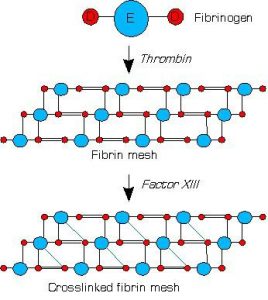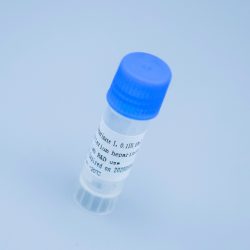Description
Factor XIII is a transglutaminase that circulates in the plasma as a heterotetramer of two catalytic A subunits and two carrier B subunits. When thrombin has converted fibrinogen to fibrin, the latter forms a proteinaceous network in which every E-unit is crosslinked to only one D-unit. Factor XIII is activated by thrombin into factor XIIIa; its activation into Factor XIIIa requires calcium as a cofactor. A cleavage by thrombin between residue Arg37 and Gly38 on the N-terminus of the A subunit, leads to the release of the activation peptide (MW 4000 da). In the presence of calcium the carrier subunits dissociate from the catalytic subunits, leading to a 3D change in conformation of factor XIII and hence the exposure of catalytic cysteine residue. Upon activation by thrombin, factor XIIIa acts on fibrin to form γ-glutamyl-Є-lysyl amide cross links between fibrin molecules to form an insoluble clot.
Activated factor XIII (FXIIIa) is mainly used to Raw Material of Thromboelastometer Reagent.
Physical and Chemical Properties
| Origin | Ruminant plasma | Appearance | lyophilized powder |
|---|---|---|---|
| EC No. | 2.3.2.13 | Specific activity | >80IU/mg protein |
| Molecular structure | Shown in the right figure | Concentration | >2mg/ml |
| Molecular weight | About 320 kDa | Purity (SDS-PAGE) | ≥ 95% |

Usage
- Reconstitute the entire contents of a vial in distilled water or buffer to obtain an appropriate solution.
- The solution could be kept at 2 to 8 °C for about one month.
- Wear gloves and avoid breathing vapors, mist or gas generated from this material.
Caution
This product is only used for laboratory R&D and industrial quality control.
Do NOT use it as drugs or in vivo experiments.




Reviews
There are no reviews yet.